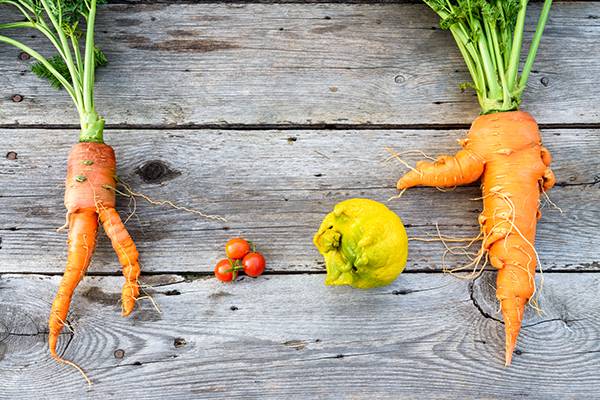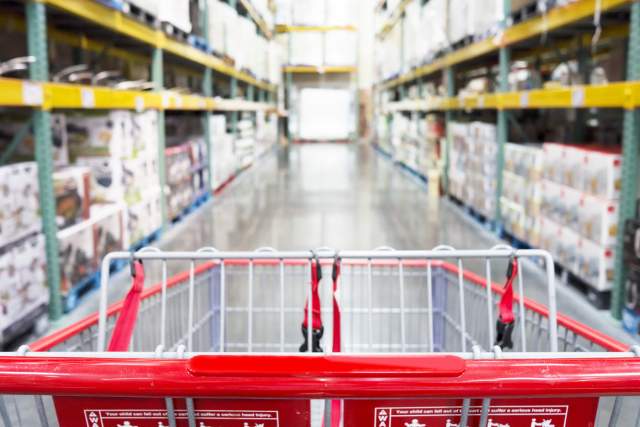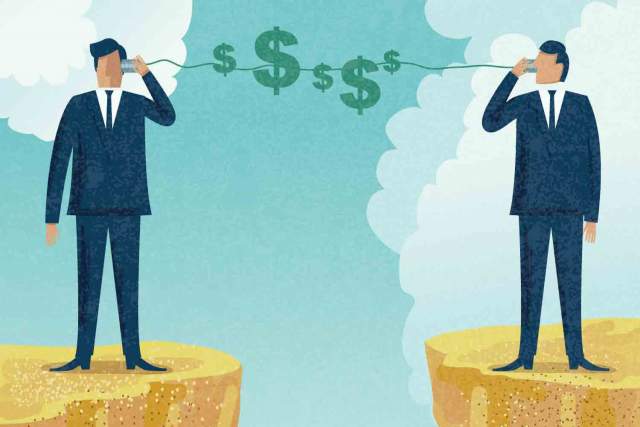Why We Avoid Ugly Food (and What to Do About It)
Tuck professor Lauren Grewal finds that consumers’ food choices are related to self-perception.

Tuck professor Lauren Grewal’s research finds that ideas of our own beauty are tied up with the beauty of the things we consume.
Fruits and vegetables come in all shapes and sizes, and for each type of produce you probably have easy access to a mental picture of the perfect specimen.
That smooth and shiny red apple, for example, or that richly orange and conical carrot. It should come as no surprise that we think fondly of these aesthetic standard-bearers. But the corollary is also true: ugly produce is the pariah of the grocery aisle—discounted, overlooked, thrown away. Of course, food doesn’t have feelings, so it’s not susceptible to these insults. The only ones we hurt are ourselves. Businesses discard around $15.4 billion of edible fruits and vegetables every year. And one in eight Americans doesn’t have enough to eat.
Lauren Grewal, an assistant professor of business administration at Tuck, has been drawn to this topic for a number of years. It exists at the intersection of her research interests on food decision making, consumer wellbeing, and the way people identify. In “The Self-Perception Connection: Why Consumers Devalue Unattractive Produce,” a forthcoming paper in the Journal of Marketing, Grewal and co-authors Jillian Hmurovic, a doctoral candidate at the Katz Graduate School of Business, Cait Lamberton of the Katz Graduate School of Business, and Rebecca Walker Reczek of the Fisher College of Business, study why people tend to avoid unattractive produce, and what marketers can do about it. Their findings put an interesting twist on the saying “beauty is in the eye of the beholder.” It turns out, ideas of our own beauty are tied up with the beauty of the things we consume.
There are two general categories of ugly produce: normally ugly (like the ugli fruit) that always looks unattractive, and abnormally ugly—when a fruit or vegetable deviates from the stereotype. Grewal’s research is concerned with the latter. Abnormally ugly produce is perfectly safe to eat, according to USDA regulations, but at every stage of the supply chain it is winnowed towards the trash bin. Farmers don’t pick ugly produce, or they toss it in the compost pile. Retailers throw it out. Consumers select the prettier items and leave the ugly ones behind. Across five experiments, Grewal and her co-authors examine the roots of this behavior, and they come up with effective interventions.
When consumers imagine consuming unattractive produce, it generates self-signaling effects, prompting them to perceive themselves more negatively.
In their studies they examined mediation, the technical term for the thought process that results in consumers placing a premium on attractive produce. “We found that the only thing that explained consumers’ devaluation of unattractive produce was their momentary self-perceptions,” Grewal says. Specifically, “when consumers imagine consuming unattractive produce, it generates self-signaling effects, prompting them to perceive themselves more negatively and, consequently, reducing their purchase of, choice of, and willingness to pay for unattractive produce. In that moment, a consumer’s self-perceptions are immediately lower than they would be if they were imagining themselves eating that perfect strawberry.”
In addition to studying mediation, the researchers also determined moderators of their effect: situations or scenarios that could mitigate the negative self-perception people have when they think about ugly produce. One of the two moderators they considered was boosting a consumer’s self-esteem. What kind of scenario accomplished this? In one experiment conducted in a grocery store, the researchers put up posters near the disagreeable fruit and vegetables that says, “You’re fantastic! Buy ugly produce.” These had the effect of boosting shoppers’ momentary self-esteem, lessening the negative self-perception effects of the ugly produce. “Yes, it’s still ugly, but as your self-perceptions are protected by that self-esteem boost, you do not feel worse about yourself, thus, your willingness to purchase is not negatively impacted,” Grewal says.
This simple intervention could save retailers a lot of money. If a retailer offered a 30-percent discount to get rid of ugly produce, the researchers found, through back-of-the-envelope calculations, that self-esteem-boosting signs could increase revenue in the category by 12.6-percent. If a store offered no discounts, the signs could raise revenue by 19.4-percent.
“It’s billions of dollars and billions of pounds of food waste, which is staggering when you think about how many people go hungry,” Grewal says. The finding has even changed the way she shops. “I only buy ugly produce now,” she says, “it makes me feel pretty good when I bake and post pictures of my food made from ugly ingredients.”

